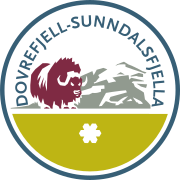Dovrefjell-Sunndalsfjella National Park
| Dovrefjell–Sunndalsfjella National Park | |
|---|---|
|
IUCN category II (national park)
|
|
 |
|

Dovrefjell in late autumn
|
|
| Location | Oppland, Sør-Trøndelag, and Møre og Romsdal, Norway |
| Nearest city | Trondheim |
| Coordinates | 62°23′48″N 9°10′23″E / 62.39667°N 9.17306°ECoordinates: 62°23′48″N 9°10′23″E / 62.39667°N 9.17306°E |
| Area | 1,693 km2 (654 sq mi) |
| Established | 3 May 2002 |
| Governing body | Dovrefjell nasjonalparkstyre (Dovrefjell National Park Board) |
Dovrefjell–Sunndalsfjella National Park (Norwegian: Dovrefjell-Sunndalsfjella nasjonalpark) is a National Park in Norway. It was founded in 2002 to replace and enlarge the former Dovrefjell National Park, which had been founded in 1974. It occupies 1,693 km² and encompasses areas in three Norwegian counties: Oppland, Sør-Trøndelag, and Møre og Romsdal and includes large parts of the mountain range of Dovrefjell. Together with the National Park eight Landscape Protected areas and two Biotope Protected Areas were established adjacent to the park in 2002, comprising a total protected area of 4366 km2 including also parts of Hedmark county.
The National Park was established to
- preserve a large, continuous and essentially untouched mountain area,
- preserve an alpine ecosystem with its natural biodiversity,
- preserve an important part of the range of the stocks of wild reindeer in Snøhetta and Knutshø,
- safeguard a variation in habitats,
- preserve the landscape morphology and its distinctive geological deposits,
- protect cultural heritage.
The public do have access to experience the nature through the exercise of the traditional and simple outdoor life, with technical infrastructure only established to a very modest extent.
In short: To preserve an intact alpine ecosystem with its indigenous wild reindeer. Together with the reindeer in Rondane National Park the last remaining population of wild Fennoscandian reindeer of Beringia origin (other wild Norwegian reindeer are of European origin and have interbred with domesticated reindeer to a various extent), wolverine, and various large birds as golden eagle and gyrfalcon can be seen, and also the recently (1930s) imported (and potentially dangerous) musk oxen. Some of the plant life predates the last ice age.
...
Wikipedia
